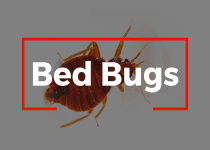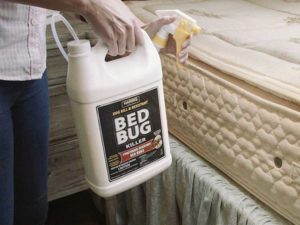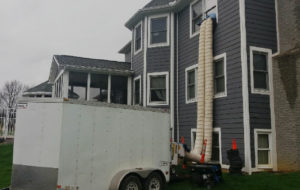Integrity Bed Bug Solutions
If you’re looking for answers on how exterminators manage to get rid of one of the most resilient household pests we have to contend with, you’ve come to the right place!
- In this article, we’re going to run you through the three main ways an exterminator will work to remove bed bugs from your household.
- You’ll also learn about the ways bed bug treatment has changed over the past fifty years. You may discover that many things you thought you knew about how to get rid of bed bugs are out of date!
- Finally, we’ll tie all that together to get you up to speed on the three crucial things a good exterminator will do before starting the bed bug control process.
Knowledge is power, right? So let’s get you powered up to effectively deal with these irritating, embarrassing, and ridiculously resilient little pests.
And remember, if you’re looking for bed bug exterminations in Cincinnati, we’re here to help!
Three Ways to Get Rid of Bed Bugs
There are a plethora of bed bug treatments out there. Mattress covers, furniture interceptors, vacuuming, and steam, are all methods you’ll see discussed on YouTube or mentioned in pest eradication forums.
Customers ask us about these all the time, wanting to know if they’re effective solutions.
The short answer?
They all have their place.
When we work with a client to destroy their bed bugs, we will almost certainly bring a combination of these methods into play. But none are strong enough to make a dent in isolation.
The real grunt work of bed bug control rests on chemical treatment, cold treatment, or heat treatment. These three bed bug treatments are what we’ll look at in greater detail in this article.
Chemical Treatment
It’s a relatively common and understandable trait to seek out quick and easy solutions. Ask most people with an illness which they’d prefer for treatment: a single pill or a course of physical therapy. Nine out of ten will take the pill, for obvious reasons.
It’s just the same with pest extermination.
Here’s a quick (we promise!) history lesson. For years, if you needed to get rid of bed bugs, some form of insecticide would be used, often delivered via fumigation. For the last hundred years, we’ve resorted to a pharmacopeia of toxic substances, from sulfur to mercury chloride.
Then Dichlorodiphenyltrichloroethane (don’t worry, we can’t pronounce it either) came along. With DDT, everything changed. Suddenly, we were armed with a compound that wouldn’t just kill off your current infestation, but which would keep killing new waves of bugs. Moreover, this magical stuff could get rid of bed bugs at every stage of their life cycle, from eggs to mature adults.
So the obvious question is, why isn’t this the silver bullet we’re using today?
Two words: insecticide resistance.
In the 1960s, we thought we’d all but eradicated bed bugs in the US. But today, we’re dealing with a nationwide epidemic.
The reason is kind of scary.
Bed bugs have slowly but surely developed resistance to DDT. Science tried to stay ahead of the bugs, devising successive waves of DDT alternatives – lindane, chlordane, diazinon – but all ultimately lost their effectiveness.
Being the highly adaptable creatures they are, bed bugs developed an arsenal of behavioral, morphological, and biochemical defenses against chemical treatments.
Put simply, they kept coming back stronger.
The more chemicals we threw at them, the more chemical resistant they became.
Chemicals are still in use today, but hopefully, this quick history of our chemical war on bed bugs will show you why, these days, chemical treatments are rarely the definitive solution to a bed bug infestation. They can help. But we needed to find better weapons to get rid of bed bugs.
When chemicals are used, they almost always require multiple applications, more significant disruption to your home, and higher overall financial outlay.
Cold Treatment
When the full extent of chemical resistance became a known quantity, exterminators faced the challenge of finding a new line of attack.
One method we hit on was cold treatment.
It’s pretty self-explanatory, really. Using a device that distributes frozen Carbon Dioxide, the exterminator’s goal is to snap-freeze and insta-kill all bed bugs and bed bug eggs on a treated surface.
Cold treatment side-steps the whole chemical resistance problem, and owing to its focus on extreme environmental change, affords bed bugs limited opportunity to evolve biological resistance.
Further improving the case for cold over chemicals, this is a non-toxic solution. We’re talking about no residues, no harmful pollutants, and a much better outcome all around for the environment.
Do you sense a “but” coming?
Here’s the big problem with using cold treatments: Sure, bed bugs may not be able to adapt resistance as they have over the years with chemicals, but bed bugs are naturally highly resistant to the cold.
Did we mention these things are ridiculously resilient?
To get rid of bed bugs, cold simply isn’t the best solution. A bed bug can survive happily at temperatures approaching minus 15 Fahrenheit. Moreover, you’ll need to keep temperatures down near that level for days before you can definitively know the population has been eradicated.
If you think that sounds hard to achieve, you’re one hundred percent right.
Oh, and you know how bed bugs inhabit cracks and crevices, like mattresses, bed frames, cushions, and clothing? All that stuff happens to be insulation. The more burrowed-in a bed bug is, the harder it is to expose it to lethal cold. The bed bugs you most have to worry about remain mostly untouched.
Not cool (or at least, not cool enough).
The bottom line is, while cold improves our options somewhat, quite frustratingly, it still lacks that silver bullet effectiveness.
Heat Treatment
Then there’s heat. Again, you won’t need a complex diagram to understand why this extermination strategy works.
A carefully positioned battery of ultra-powerful heaters are used in conjunction with fans to circulate hot air throughout an affected home.
What level of heat are we talking about here?
The goal is to get the air heated to greater than 130 degrees Fahrenheit.
The research tells us a bed bug population will begin to die out at temperatures hovering around 110 degrees. Bump that up to greater than 120, and you hit a biological tipping point, and the bed bugs die – pretty much instantly.
And here, we’re finally getting close to a solution that sticks.
It turns out, bed bugs are tough, but heat is their biggest – perhaps their only! – readily exploitable vulnerability.
The other thing about heat is that it’s easier to achieve than cold.
Now, 130 degrees Fahrenheit sounds pretty darn hot. And don’t get us wrong, you wouldn’t want to hang out in that heat. But it is a lot easier to bump the ambient temperature of a house up to this level of heat than it is to get it down to minus 15 Fahrenheit.
Moreover, all that insulation those bed bugs like to hide out in? It’s far less good at resisting heat than cold. Heat gets into cracks and crevices that cold and chemicals are less likely to touch.
All of this begs the question, then. Is heat treatment the silver bullet treatment method for getting rid of bed bugs? Is it the answer for which we’ve all been looking?
Well, yes and no.
Bed bugs infestations are still hard to manage. As far as insects go, bed bugs are pretty much the perfect storm of sneakiness, toughness, and capacity to spread.
But heat is, without question, one of the most effective treatments we have for hitting the little blighters where they’re most vulnerable.
In most situations, some augmentation with additional chemical treatments is part of the solution. But in our many years of experience, heat is the best way to get rid of bed bugs, hands down. Even if it isn’t the whole solution, it should be part of every bed bug extermination strategy.
You also have simple logistics to consider. Heat treatment is:
- Less disruptive than chemical treatment.
- More straightforward to achieve than cold treatment.
- The safest and least expensive option available to the industry.
How to Choose a Good Exterminator
Now you know more about bed bugs and the methods at our disposal to get rid of them. But there’s one other important part to the bed bug picture: the people doing the exterminating.
How do you pick a good’ un?
This is a really important question.
A lot of people out there claim to deliver a professional service, but finding the real deal – businesses with cutting edge equipment, years of collective extermination experience, and backed up by hardcore entomological expertise – are harder to find.
First, you should know what a good exterminator isn’t.
Three Misconceptions About Exterminators
- A good exterminator is all about extermination:
Nope. Killing isn’t enough.
A good exterminator’s focus is all about stopping the life cycle of the bugs, starting right at reproduction. That’s the only way to keep bed bugs out of your home, not just tomorrow, but six months from now.
Take-home point Number One: The best tool an exterminator has is a deep understanding of bed bug biology.
- A good exterminator will only use one method to get the job done:
Often it sounds a bit like this: “This guy’s great because he has all the nasty, deadly chemicals.” Chemicals are part of the picture, but for all the reasons we explained above, they aren’t the whole picture.
Very occasionally, one method of bed bug eradication will work on its own. But the vast majority of the time, a good exterminator will be all about integrated pest management, a process of carefully combining a range of extermination methods to attack bugs on multiple fronts.
Take-home point Number Two: A good exterminator is looking for a total pest control strategy, and this usually requires a combination of treatment and preventative strategies.
- A good exterminator will always opt for the “nuclear” solution:
Many of our customers imagine we’ll rock up to your home in an Haz-Mat suit with weapons-grade chemicals strapped to our back.
Some people find this idea terrifying. Others find it reassuring.
But the truth of it is, the age of shock and awe chemical treatments for bed bugs is behind us. It doesn’t work. It’s bad for the environment. Oh, and did we mention it just doesn’t work? There are far more effective bed bug extermination methods (namely, our good friend, heat treatment).
Take-home point Number Three: More toxic does not mean more effective.
Here’s What a Good Exterminator Will Do Differently
It boils down to three things. A good exterminator will:
- Inquire – They’ll always ask you questions. Where have you seen evidence of bugs? Did you recently purchase second-hand furniture? What happened in your home before you noticed them? Do you have bug bites? Do you have pets? Allergies? All these questions are a crucial part of finding a treatment strategy that’ll work for you.
- Investigate – And by investigate, think Sherlock Holmes level investigation! A proficient exterminator will forensically examine your home to better understand the problem you’re facing.
- Integrate – Years of experience (and a substantial body of excellent research) have demonstrated to us, time and again, that heat treatment should be part of every bed bug extermination strategy. However, a good bed bug exterminator will be well-versed in ways to bring a careful use of supplementary chemical treatments into play to support the heat treatment.
Integrity Bed Bug Solutions
Integrity Bed Bug Solutions is a company that is passionate about providing complete and thorough treatment of bed bug infestations. Our goal is to make sure that our clients are fully satisfied with the service we provide and the results we achieve.
We offer a complete range of services, including:
• Inspection and assessment
• Treatment for all areas where bed bugs have been found or suspected
• Removal of any items that need to be disposed of due to contamination
• Deodorization of living spaces and furnishings
List Of Integrity Bed Bug Solutions
- Protects Against Urine, Fluids, Perspiration
- Cotton Terry Surface With Membrane Back Coating (Waterproof, Noiseless and Breathable)
- Great For Those With Kids, Pets Or Incontinence (OEKO-TEX Certified SH025 151792)
- Will Not Change The Feel of Your Mattress (Registered with the FDA as a Class 1 Medical Device)
- Fitted Sheet Style Design – Queen Size Mattress Protector 60″ x 80″ – Fits up to 18″ deep
Additional Info :
| Color | White |
| Item Dimensions | |
| Height | 11.1 Inches |
| Width | 3.6 Inches |
| Length | 11.5 Inches |
| Weight | 1 Pounds |
- Every Purchase Saves Pets. BISSELL proudly supports BISSELL Pet Foundation and its mission to help save homeless pets.
- Clean and Sanitize with the Power of Steam. 100 watts of steam power from a variety of hard surfaces.
- On-Demand Steam Trigger. Control the amount of high-pressure, high-temperature steam.
- Cleaning Tools Included. Comes with seven multi-surface cleaning tools: jet nozzle, (3) color-coded round bristle brushes, grout tool, flat scraper tool, and angle concentrator tool.
- Chemical-Free Cleaning. Uses water only, 100% natural cleaning is safe for kids and pets.
- Use as instructed. Results may vary. Tested under controlled laboratory conditions without tools.
- When used as directed.
Additional Info :
| Color | Silver |
| Item Dimensions | |
| Height | 8.5 Inches |
| Width | 9.5 Inches |
| Length | 5 Inches |
| Weight | 3.8360433588 Pounds |
| Release Date | 2019-08-01T00:00:01Z |
- Say Goodbye to Bugs – Kills a variety crawling insects including roaches, ants, fleas, silverfish, earwigs, bedbugs, and more
- Attracts and Kills – Made from diatomaceous earth and selected baits, this powder causes insects to dehydrate and die within 48 hours after contact
- Mechanical Killer – Unlike many traditional chemical insecticides, insects cannot build an immunity to diatomaceous earth
- Use Where Insects Hide – DE can be used indoors or outdoors. Apply in cracks and crevices, along baseboards, or create a barrier around entry points
- Peace of Mind – This powder is OMRI Listed and compliant for use in organic gardening so you can use it without worry
Additional Info :
| Item Dimensions | |
| Height | 4.2 Inches |
| Width | 10.8 Inches |
| Length | 15.6 Inches |
| Weight | 4.2 Pounds |
Additional Info :
| Item Dimensions | |
| Height | 10 Inches |
| Width | 0.5 Inches |
| Length | 4 Inches |
Additional Info :
| Item Dimensions | |
| Height | 9 Inches |
| Width | 0.25 Inches |
| Length | 6 Inches |
| Weight | 0.5 Pounds |
| Release Date | 2021-10-26T00:00:01Z |








